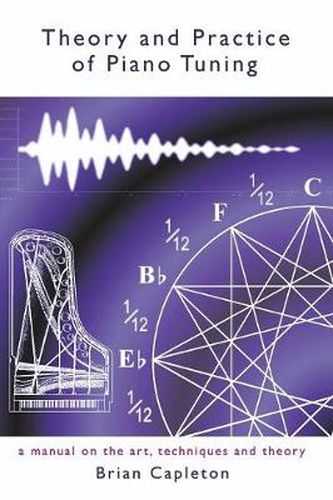Readings Newsletter
Become a Readings Member to make your shopping experience even easier.
Sign in or sign up for free!
You’re not far away from qualifying for FREE standard shipping within Australia
You’ve qualified for FREE standard shipping within Australia
The cart is loading…






This title is printed to order. This book may have been self-published. If so, we cannot guarantee the quality of the content. In the main most books will have gone through the editing process however some may not. We therefore suggest that you be aware of this before ordering this book. If in doubt check either the author or publisher’s details as we are unable to accept any returns unless they are faulty. Please contact us if you have any questions.
The new edition of the leading textbook and most comprehensive source available for both practicing piano tuners and academic researchers, on the theory and practice of piano tuning. By the former Royal National College lecturer in Piano Technology and Tuning Theory. 680 pages, with over 300 illustrations and tables. The book covers in-depth theory and practice from elementary to advanced level. It answers common questions raised by students of piano tuning about the actual soundscapes and behaviour of piano tone that are encountered in tuning practice. It is suitable for both students and professionals of piano tuning, general readers, and academics with interdisciplinary interests in the subject. Includes: Why we need skilled piano tuners Intonation and tone The distance between theory and the art Theory of sound Temperament theory Elementary traditional tuning and beat rate theory What contemporary acoustics reveals What attenuation is, and why it is so important Beyond the 19th century model - How beating and beat rates really work Beyond the 19th century model - How tempered intervals really behave in fine tuning False beat phenomenon and its influence The effects of bridge coupling How real tone- envelopes behave in fine tuning Inharmonicity and small piano syndrome What octave stretching is, why, and how it works Setting the pin - the theory behind it and how to practice it Scale plasticity, logic, and tuning technique Psychoacoustics and how to listen Contents: Acknowledgments Piano tuning and this book Part 1 - Background Theory The invisible art and science The essential ideas Sound Temperament Theory Traditional piano tuning theory and elementary practice The soundscape, spectrum and tone Partial decay patterns Part 2 - Fine Tuning Practice Unison Tuning Tuning the Scale Octave tuning Setting the Pin Setting the pitch Small piano syndrome Hearing The Kirk Experiment Part 3 - Advanced Theory The single piano string in one plane The Weinreich Model Two strings, two planes The Trichord Further comments on false partials Inharmonicity Glossary of key concepts Select bibliography
$9.00 standard shipping within Australia
FREE standard shipping within Australia for orders over $100.00
Express & International shipping calculated at checkout
Stock availability can be subject to change without notice. We recommend calling the shop or contacting our online team to check availability of low stock items. Please see our Shopping Online page for more details.
This title is printed to order. This book may have been self-published. If so, we cannot guarantee the quality of the content. In the main most books will have gone through the editing process however some may not. We therefore suggest that you be aware of this before ordering this book. If in doubt check either the author or publisher’s details as we are unable to accept any returns unless they are faulty. Please contact us if you have any questions.
The new edition of the leading textbook and most comprehensive source available for both practicing piano tuners and academic researchers, on the theory and practice of piano tuning. By the former Royal National College lecturer in Piano Technology and Tuning Theory. 680 pages, with over 300 illustrations and tables. The book covers in-depth theory and practice from elementary to advanced level. It answers common questions raised by students of piano tuning about the actual soundscapes and behaviour of piano tone that are encountered in tuning practice. It is suitable for both students and professionals of piano tuning, general readers, and academics with interdisciplinary interests in the subject. Includes: Why we need skilled piano tuners Intonation and tone The distance between theory and the art Theory of sound Temperament theory Elementary traditional tuning and beat rate theory What contemporary acoustics reveals What attenuation is, and why it is so important Beyond the 19th century model - How beating and beat rates really work Beyond the 19th century model - How tempered intervals really behave in fine tuning False beat phenomenon and its influence The effects of bridge coupling How real tone- envelopes behave in fine tuning Inharmonicity and small piano syndrome What octave stretching is, why, and how it works Setting the pin - the theory behind it and how to practice it Scale plasticity, logic, and tuning technique Psychoacoustics and how to listen Contents: Acknowledgments Piano tuning and this book Part 1 - Background Theory The invisible art and science The essential ideas Sound Temperament Theory Traditional piano tuning theory and elementary practice The soundscape, spectrum and tone Partial decay patterns Part 2 - Fine Tuning Practice Unison Tuning Tuning the Scale Octave tuning Setting the Pin Setting the pitch Small piano syndrome Hearing The Kirk Experiment Part 3 - Advanced Theory The single piano string in one plane The Weinreich Model Two strings, two planes The Trichord Further comments on false partials Inharmonicity Glossary of key concepts Select bibliography